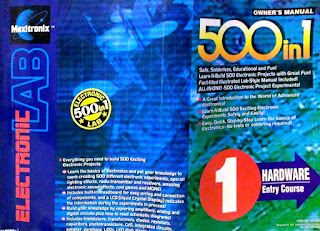I owned one of these kits twice, once as a very young child and then a second time after college. I was too young the first time and there was no one to help me troubleshoot the circuits. Anyone who has spent hours debugging a breadboarded circuit only to find out they have one resistor leg in the wrong slot or two leads touching can relate to my frustration.
I did learn a lot, but I would have learned more if I had been mentored in how to track down errors and correct them. The successes were sweet, but I had too many failures and I could not dependably make a circuit work, so the kit went into deep storage.
 |
| Yes I still have one of the manuals that came with my Radio Shack 500-in-1 Electronics Lab kit. I don't use it very often but the circuits are still valid today. |
But the seeds for electronic tinkering had been planted. When the whole Arduino (and LEGO Mindstorms) thing exploded onto the scene I bought a second kit from Radio Shack. This time it went a lot better for me. I knew more about troubleshooting, both because of my experience with software design, and because I knew a few tinkerers who helped me identify the most common breadboarding errors.
I never went much beyond making basic sensors for my robots and UNOs, but exploring the wide variety of circuits helped cement some core concepts in my brain. These circuits are still fun and it's great to have them all in one place. Some days I don't feel like coding, so a nice, simple, all passives project might be fun.
They also have a lot of the Forrest Mims notebooks. These classic booklets started many a child's (or adult's) electronics journey. Still classics and still referenced by lots of people as inspiration. You might not know Mims work, but the people who run the companies you buy your kits from will know his name, and may (like me) still have an original booklet.
No comments:
Post a Comment